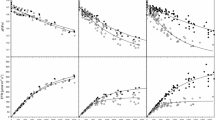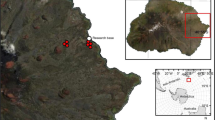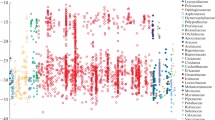Summary
-
1.
The 4 alpine species of Sempervivum (S. arachnoideum L., S. montanum L., S. soboliferum Sims, S. wulfenii Hoppe) analyzed in this study showed acidification during the dark period in their natural habitat. The δ13C value of these species varied according to the water supply at their natural habitat, being less negative at dry sites. These data are consistent with a larger contribution of dark CO2 fixation via Phosphoenolpyruvate-Carboxylase in relation to light CO2 fixation via Ribulose-1, 5-diphosphate Carboxylase. These alpine Sempervivum spp. behave, therefore, like typical CAM-plants.
-
2.
In contrast, the 3 alpine species of Sedum analyzed in this respect (S. acre. L., S. alpestre Vill., S. rosea (L.) Scop.) showed no pronounced dark acidification. The δ13C value of the 8 alpine Sedum species examined in this study (the 3 mentioned above and S. album L., S. atratum L., S. dasyphyllum L., S. reflexum L., S. sexangulare L.) was much more negative than in the Sempervivum spp., indicating that the dark CO2 fixation does not play a great role in the carbon metabolism of the alpine Sedum spp. in the natural habitats. Water supply in the natural habitat has no clear-cut influence on the δ13C value.
-
3.
All alpine species of Saxifraga analysed (S. seloides L., S. oppositifolia L., S. bryoides L., S. aizoides L., S. squarrosa Sieber, S. paniculata Mill., S. caesia L.) show δ13C values typical of C3 plants and they were not influended by the water conditions in the natural sites. Saxifraga paniculata showed no dark acidification in its natural habitat and we suspect that alpine Saxifrages are not CAM plants.
-
4.
Based on δ13C values the alpine plants Pinguicula alpina L., Thesium alpinum L., and Linaria alpina (L.) Mill. are typical C3 plants.
Similar content being viewed by others
References
Allaway, W. G., Osmond, C. B., Troughton, J. H.: Environmental regulation of growth, photosynthetic pathway and carbon isotope discrimination in plants capable of crassulacean acid metabolism. In: R. L. Bieleski, A. R. Ferguson, M. M. Cresswell, eds., Mechanisms of regulation of plant growth, Bulletin 12, p. 195–202. Wellington: Royal Society of N.Z. 1974
Bender, M. M., Rouhani, I., Vines, H. M., Black, C. C., Jr.: 13C/12C ratio changes in crassulacean acid metabolism. Plant Physiol. 52, 427–430 (1973)
Craig, H.: Isotope standards for carbon and oxygen and correction factors for mass-spectrometric analysis of carbon dioxide. Geochim. et cosmochim. Acta 12, 133 (1957)
Kluge, M., Fischer, K.: Über Zusammenhänge zwischen dem CO2-Austausch und der Abgabe von Wasserdampf durch Bryophyllum daigremontianum. Planta (Berl.) 77, 212–223 (1967)
Lerman, J. C.: Isotopic composition of plants variations due to environmental change. In: R. Marcelle, ed., Environmental and biological control of photosynthesis, The Hague: Junk 1975
Lerman, J. C., Queiroz, O.: Carbon fixation and isotope discrimination by a crassulacean plant: dependence on the photoperiod. Science 183, 1207–1209 (1974)
Osmond, C. B.: Environmental control of photosynthetic options in Crassulacean plants. In: R. Marcelle, ed., Environmental and biological control of photosynthesis, p. 299–309. The Hague: Junk 1975
Osmond, C. B., Allaway, W. G., Sutton, B. G., Troughton, J. H., Queiroz, O., Lüttge, U., Winter, K.: Carbon isotope discrimination in photosynthesis of CAM plants. Nature (Lond.) 246, 41–42 (1973)
Schiegl, W. E., Vogel, J. C.: Deuterium content of organic matter. Earth and planet. Sc. Letters 7, 307–313 (1970)
Smith, B. N., Brown, H. V.: The Kranz syndrome in the Gramineae as indicated by carbon isotope ratios. Amer. J. Bot. 60, 505–513 (1973)
Szarek, S. R., Johnson, H. B., Ting, I. P.: Drought adaptation in Opuntia basilaris. Significance of recycling carbon through crassulacean acid metabolism. Plant Physiol. 52, 539–541 (1973)
Szarek, S. R., Ting, I. P.: Seasonal patterns of acid metabolism and gas exchange in Opuntia basilaris. Plant Physiol. 54, 76–81 (1974)
Whelan, T., Sackett, W. M., Benedict, C. R.: Enzymatic fractionation of carbon isotopes by phosphoenol pyruvate carboxylase from C4 plants. Plant Physiol. 51, 1051–1054 (1973)
Author information
Authors and Affiliations
Rights and permissions
About this article
Cite this article
Osmond, C.B., Ziegler, H., Stichler, W. et al. Carbon isotope discrimination in alpine succulent plants supposed to be capable of crassulacean acid metabolism (CAM). Oecologia 18, 209–217 (1975). https://doi.org/10.1007/BF00345423
Received:
Issue Date:
DOI: https://doi.org/10.1007/BF00345423




